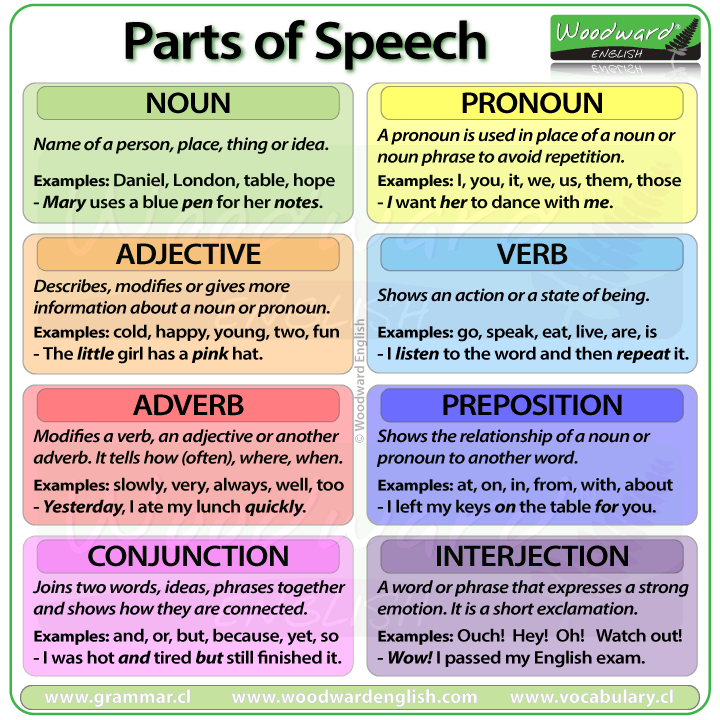The parts of speech explain how a word is used in a sentence.
There are eight main parts of speech (also known as word classes): nouns, pronouns, adjectives, verbs, adverbs, prepositions, conjunctions and interjections.
Most parts of speech can be divided into sub-classes. Prepositions can be divided into prepositions of time, prepositions of place etc. Nouns can be divided into proper nouns, common nouns, concrete nouns etc.
It is important to know that a word can sometimes be in more than one part of speech. For example with the word increase.
Increase can be a verb e.g. Prices increased
and increase can also be a noun e.g. There was an increase in the number of followers.
The eight main parts of speech in English are:
NOUN - (Naming word)
A noun is the name of a person, place, thing or idea.
Examples of nouns: Daniel, London, table, dog, teacher, pen, city, happiness, hope
Example sentences: Steve lives in Sydney. Mary uses pen and paper to write letters.
Learn more about the different types of nouns.
PRONOUN - (Replaces a Noun)
A pronoun is used in place of a noun or noun phrase to avoid repetition.
Examples of pronouns: I, you, we, they, he, she, it, me, us, them, him, her, this, those
Example sentences: Mary is tired. She wants to sleep. I want her to dance with me.
ADJECTIVE - (Describing word)
An adjective describes, modifies or gives more information about a noun or pronoun.
Examples: big, happy, green, young, fun, crazy, three
Example sentences: The little girl had a pink hat.
VERB - (Action Word)
A verb shows an action or state of being. A verb shows what someone or something is doing.
Examples: go, speak, run, eat, play, live, walk, have, like, are, is
Example sentences: I like Woodward English. I study their charts and play their games.
ADVERB - (Describes a verb)
An adverb describes/modifies a verb, an adjective or another adverb. It tells how, where, when, how often or to what extent. Many adverbs end in -LY
Examples: slowly, quietly, very, always, never, too, well, tomorrow, here
Example sentences: I am usually busy. Yesterday, I ate my lunch quickly.
PREPOSITION - (Shows relationship)
A preposition shows the relationship of a noun or pronoun to another word. They can indicate time, place, or relationship.
Examples: at, on, in, from, with, near, between, about, under
Example sentences: I left my keys on the table for you.
CONJUNCTION - (Joining word)
A conjunction joins two words, ideas, phrases or clauses together in a sentence and shows how they are connected.
Examples: and, or, but, because, so, yet, unless, since, if.
Example sentences: I was hot and exhausted but I still finished the marathon.
INTERJECTION - (Expressive word)
An interjection is a word or phrase that expresses a strong feeling or emotion. It is a short exclamation.
Examples: Ouch! Wow! Great! Help! Oh! Hey! Hi!
Example sentences: Wow! I passed my English test. Great! – Ouch! That hurt.
Summary Chart
Sometimes teachers include Articles as a ninth part of speech so we have included it here. Note, an article is a type of adjective.
ARTICLE - (Defining word)
An article is used before a noun. These are divided into definite (the) and indefinite (a, an). Articles help define nouns.
Examples: a, an, the
Example sentences: I need a dictionary. The dictionary needs to be in English.








0 Comments